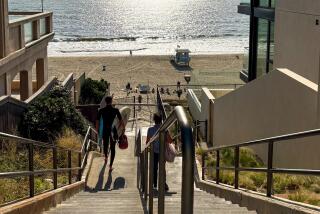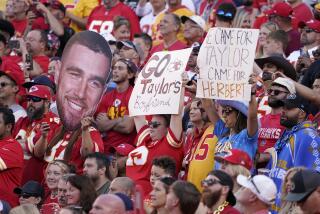On the Hammett Trail
- Share via
SAN FRANCISCO — The Hall of Justice was dirty and reeked of evil. The City Hall, the D.A. and the cops ran the town as though they owned it, and they did. . . . You could play roulette in the Marina, shoot craps on O’Farrell, play poker on Mason, and get rolled at 4 a.m. in a bar on Eddy.
--Columnist Herb Caen, on the San Francisco of the Roaring ‘20s
During the 1920s this was Dashiell Hammett’s kind of town, dangerous, exciting, lawless--the sort of place that stirred the creative juices of a veteran private detective with ambitions of becoming a writer.
These days Fog City is considerably less rambunctious than it was during the flapper era. But for $5 you can spend 3 1/2 hours in the San Francisco of Hammett’s day, a time when villains committed dark deeds under a cloak of chilled night fog, a place where ace investigator Sam Spade walked the nocturnal streets gathering evidence, shadowing suspects, rolling cigarettes.
To travel back to Hammett’s San Francisco of the ‘20s, plant yourself on the steps of the San Francisco Public Library (Larkin and McAllister streets) at noon on any Saturday, May through August, and watch for a suspicious character in a London Fog overcoat and fedora.
The mystery man will be Don Herron, a writer/cab driver and would-be gumshoe and creator of the Dashiell Hammett Tour of San Francisco. He will lead you down alleys and up hills, through the street life of the Tenderloin and the glamour/clamor of Nob Hill, back down to the commercial chaos of Union Square and finally into a restaurant-bar in the Financial District.
In the Words of Spade
Herron will tell you about murder, extortion, alcoholism, adultery, tuberculosis. And, in the immortal words of Sam Spade, as portrayed by Humphrey Bogart in the 1941 film version of Hammett’s novel, “The Maltese Falcon”: “You’ll take it . . . and you’ll like it.”
Hammett was larger than life, Herron explains, a hard-boiled, no-nonsense man who chased criminals and women, created vivid, memorable characters, drank too much, suffered from tuberculosis yet chain-smoked, made and spent a million dollars, supported radical politics, and was jailed and blacklisted for refusing to name names during the McCarthy era.
Although the author of “The Maltese Falcon” (1929) and “The Thin Man” (1933) made his name and fortune years later in New York and Hollywood, it was in San Francisco that Hammett set aside his career as an operative for the Pinkerton National Detective Agency and began pecking away at his typewriter.
Hammett lived in San Francisco from 1921 to 1929 and, because of later troubles with writer’s block, alcoholism and the McCarthy blacklist, completed the majority of his writing here. The Prohibition-era city of hills and hoods is the vivid setting for three of Hammett’s five novels and 28 short stories.
Raymond Chandler, whose private eye yarns such as “The Big Sleep” adeptly captured 1930s Los Angeles, best summed up Hammett’s success as a writer: “Hammett did not write detective stories at all--merely hard-boiled chronicles of mean streets with a perfunctory mystery element dropped in like the olive in a martini.”
Quit School at 14
On the library steps, Herron briefs you on the Hammett file. Born May 27, 1894, in St. Mary’s County, Md., Samuel Dashiell Hammett grew up in Philadelphia and Baltimore. He quit high school at age 14 to help support the family. As a young man, Hammett worked at a variety of menial jobs.
Herron quotes from a letter in which Hammett explained his early employment record: “I became the unsatisfactory and unsatisfied employee of various railroads, stockbrokers, machine manufacturers, canners, and the like. Usually I was fired.”
In Baltimore, Hammett was brought in as an operative for Pinkerton. It was, according to Herron, “a deciding moment for popular fiction,” as Hammett’s five years with the agency gave him a colorful cast of characters and a score of pulp magazine plots. As a Pinkerton detective Hammett traveled America, eventually landing in a Tacoma, Wash., hospital with tuberculosis. He moved to San Francisco in 1921 to marry his nurse, Josephine Dolan.
The first stop on the Hammett walk is 620 Eddy St., a four-story 1920s apartment house in the street-wise Tenderloin area, where Chinese children play in an alley and a barefoot woman stands on a corner cursing an unseen enemy.
The building was recently painted baby blue and is directly across from the Phoenix, an eccentric hotel popular with visiting rock stars. Hammett, his wife and daughter lived in this building for five years.
Days in the Library
It was the couple’s first San Francisco apartment, a $25-a-month flat with a Murphy bed in the hallway and rum runners for landlords. Having quit Pinkerton because of poor health, Hammett spent numerous days in the nearby library, developed an interest in fiction, and set his mind to writing, slugging out 50 “Continental Op” mysteries.
The next Hammett residence on the walk is 891 Post St., a brown brick Tenderloin apartment building anchored by a Chinese beauty salon and dry cleaners in a neighborhood full of three- and four-story 1920s residence hotels and apartment houses.
“This is where Hammett created Sam Spade,” Herron said. Bogey comes to mind, tough and world-weary, sassing a police detective who is questioning him for murder: “It’s a long while since I burst out crying because policemen didn’t like me.”
The tour progresses up Hyde Street past such curious landmarks as the First Chinese Southern Baptist Church, up Clay Street and down Leavenworth. We cross the line between fact and fiction atop California Street on Nob Hill, where Herron pointed out the Cathedral Apartments, a 16-story building from 1927 that now houses upscale condominiums.
“Think of it as the Coronet apartments,” he said, “where Brigid O’Shaughnessy lived in ‘The Maltese Falcon.’ ” With that, Herron re-created Brigid’s attempts to portray herself to Spade as a helpless heroine, when really she was a murderess and a schemer.
“Help me,” she pleads. “You won’t need much of anybody’s help,” is Spade’s cool reply. “You’re good. You’re very good. It’s chiefly your eyes, I think, and that throb you get in your voice when you say things like, ‘Be generous, Mr. Spade.’ ”
In the Alley
After climbing Nob Hill, passing the Fairmont Hotel, cable cars and camera-clicking tourists, the tour winds downhill to an important Hammett destination: Burritt Street. In this dead-end alley off Bush Street Brigid O’Shaughnessy stopped Miles Archer’s heart with a .38 pistol.
In 1974 Hammett fans arranged to have a marker placed on the corner as a memorial to the fictitious murder. The plaque, the only one associated with Hammett in San Francisco, reads: “On approximately this spot Miles Archer, partner of Sam Spade, was done in by Brigid O’Shaughnessy.”
In Union Square we walked along sidewalks paved with pigeons, shoppers, bag ladies and conventioneers, and paused in front of a San Francisco institution, the Westin St. Francis Hotel. In 1921, Herron said, a wild party of Hollywood film folk in the hotel led to the death of a B-girl and the arrest and ruin of silent film comedian Roscoe (Fatty) Arbuckle. As a Pinkerton sleuth, Hammett investigated one of the most sensational scandals of the 20th Century.
“(Arbuckle) came into the (hotel) lobby,” Hammett wrote in an official Pinkerton report on the case. “His eyes were the eyes of a man who expected to be regarded as a monster, but was not yet inured to it. He glared at me, which was amusing in a way, because I was still working for his attorneys, gathering information for his defense.”
The tour concludes at John’s Grill, 63 Ellis St., named in “The Maltese Falcon” as a place where Spade dined on “chops, baked potato and sliced tomatoes.” The restaurant offers a Sam Spade dinner, a “Bloody Brigid” cocktail and a worthwhile collection of Hammett photographs and memorabilia on its second and third floors.
Renewed Attention
Over a Dos Equis at the bar, Herron says interest in Hammett (he died in 1961 of lung cancer) has escalated in recent years. The Lillian Hellman memoirs (“An Unfinished Woman,” “Pentimento” and “Scoundrel Time”) brought renewed attention to Hammett, her companion of 30 years and her literary mentor.
In 1982 and ’83 came biographies by Diane Johnson and William F. Nolan--founder of the Dashiell Hammett Society of San Francisco--as well as a Francis Coppola-produced film noir thriller, “Hammett,” which focused on the detective/writer’s years in San Francisco.
Herron has been investigating the case of Dashiell Hammett for decades. A serious student of the mystery/science-fiction/horror genres, Herron has pieced together his Hammett walk from various sources like a gumshoe gathering clues.
He gives the tour not for the money--at $5 a pop he’s not about to crack the Fortune 500--but to keep the Hammett legend alive. Rain or shine, one person or 78, the tours go on. Herron has been conducting them since 1977.
“After a while I start to feel the way Yul Brynner must have felt in his 10,000th performance of ‘The King and I,’ ” Herron said. He keeps the tours fresh by adding new information and anecdotes, but said he plans to phase out the tour completely in a few years.
“Any job,” he says, “can get old if you do it all your life.”
But why only $5 for a tour that lasts over three hours, winds up and down hills, and covers more ground than a crack private eye?
“When you’re giving a tour devoted to a writer who supported populist causes,” Herron explains with a sly grin, “you can’t exactly charge capitalist prices.”
-- -- --
The Dashiell Hammett Tour of San Francisco begins every Saturday at noon at the San Francisco Public Library, Larkin Street at the Civic Center, through August. Tours are available by appointment throughout the year. For more information and reservations, call (415) 564-7021.
More to Read
Sign up for The Wild
We’ll help you find the best places to hike, bike and run, as well as the perfect silent spots for meditation and yoga.
You may occasionally receive promotional content from the Los Angeles Times.






